The History Colorado Center in downtown Denver was presented with an interesting proposition: Collector Marshall Fogel would allow the museum to use his substantial baseball collection, but only during the 2018 Rockies’ season. Ordinarily, museum staff have time on their side. “Usually we like around three years,” says Jason Hanson, chief creative officer at History Colorado. However, “the opportunity was now with Marshall’s collection.”
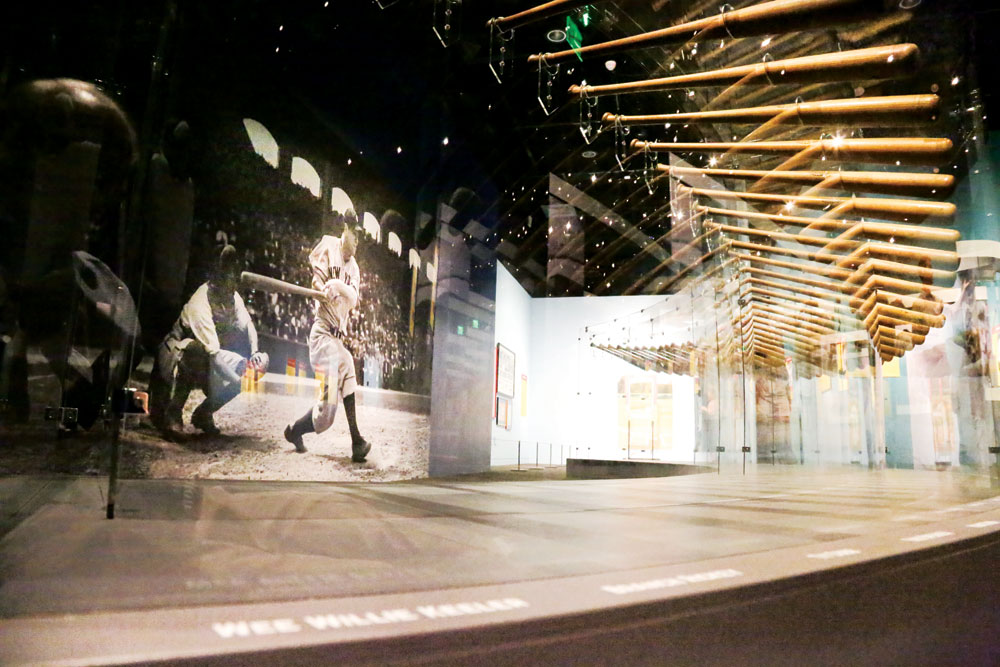
The centerpiece of the Play Ball! exhibit is this display of Lou Gehrig at bat. From the two-dimensional photo in the background, the entire arc of his swing was traced three-dimensionally with famous bats throughout baseball history.
Baseball Beyond the Ball Field
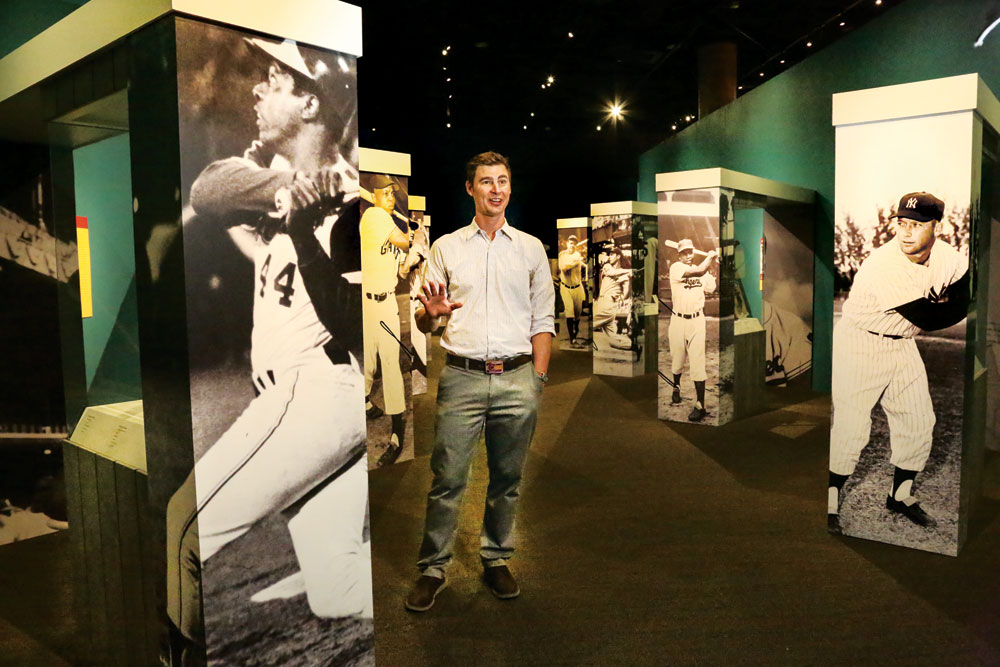
Chief creative officer, Jason Hanson walks through the Play Ball! exhibit, pausing at the Hank Aaron display on the left in the main hall.
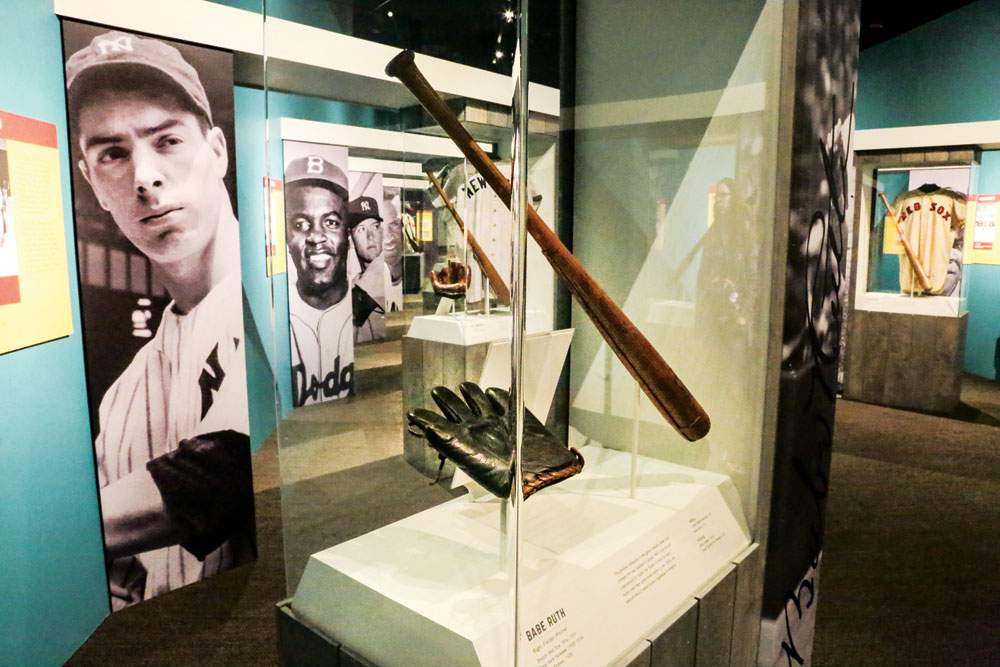
This commercial copy of Babe Ruth’s glove stands as an example of Ruth’s early celebrity status. Before there were many other super stars, people wanted to play with Ruth’s glove.
The combination of the “spectacular material” and in-house expertise allowed the museum to pull together an impressive exhibit on a truncated schedule, says Jason Hanson, chief creative officer at History Colorado. After starting last fall, they were able to open in April before the first pitch of the 2018 baseball season.
The result was a “great demonstration of what we are capable of. . . .We set a really high bar we can continue to meet,” says Hanson, as the museum aims to produce most of its exhibits in-house going forward.
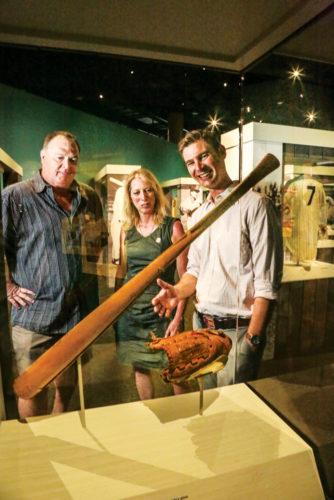
Hanson shows museum guests Daniel Murphy and Kathleen Brockel a bat and glove Roberto Clemente used. The three discussed the backwards ways the press at the time covered this highly successful Puerto Rican ball player.
Play Ball! was itself designed to reach high marks set by other baseball museums and exhibits. Hanson directly compares History Colorado’s exhibit with the Baseball Hall of Fame: “We wanted you to know you were in a Hall of Fame caliber exhibit. There are things here you could go all the way to Cooperstown to see . . . you won’t feel cheated coming here.”
For starters, Play Ball! has a remarkable collection of bats on display. From a bat used by “Wee Willie” Keeler in the 1890s to one used by contemporary Ichiro Suzuki, they cover a lot of territory. But the museum also wanted to do something special with the display.
“Usually you see bats on pegs against a wall or in a case. We wanted to bring them to life,” says Hanson. Here the bats are
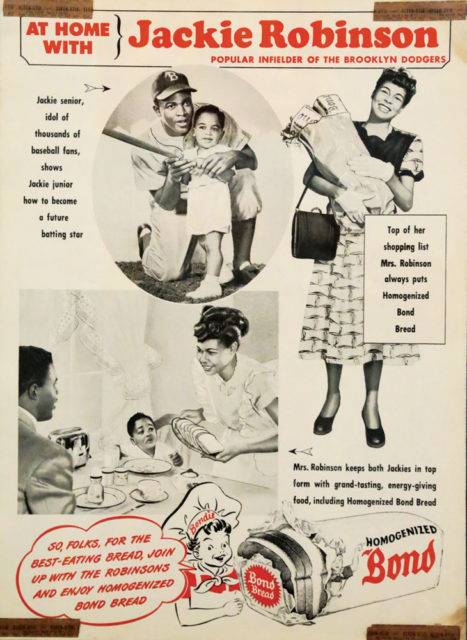
This advertisement used Jackie Robinson’s fame to sell bread and was the first national ad campaign to feature a Black family.
suspended in glass, tracing the path of Lou Gehrig’s swing. It takes the motion from the flat life-sized photograph of Gehrig in the background and adds the real bats to flesh out the scene. And, because each bat comes from a unique player, within that single swing, the museum covers a whole arc of bats and the players that swung them.
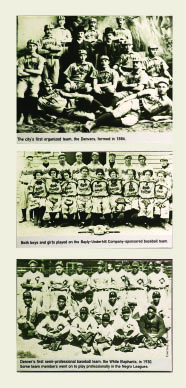
Just two years after Denver was itself established, the town held its first baseball game. Top: The Denver Denvers, stablished in 1886, preceded the more that 200 teams that flooded area ball fields by 1900. Middle:The Bayly-Underhill team was composed of men and women who worked for the Bayly-Underhill clothing manufacturing company. Bottom: Colorado was also the home of several Black baseball teams, such as the Denver White Elephants, one of the most successful and popular teams in the region during before World War Two.
Additionally, there are some elements of themuseum that even the Hall of Fame doesn’t have. One display shows memorabilia from players ineligible to be in the Hall of Fame. Banned players like “Shoeless” Joe Jackson and Mark McGuire are critical characters in baseball’s story.
While the exhibit has obvious appeal for baseball fans, Hanson says, “We tried to make a conscious effort with the artifacts we selected and the stories we told on the labels to go on beyond the ball field wherever we could.”
Items like the receipt for flowers Joe DiMaggio bought for Marilyn Monroe or the poster for the 1942 Gary Cooper film The Pride of the Yankees touch on the pervasiveness of baseball in American society. “Everyone has a favorite baseball movie,” says Hanson—just as everyone has seen the larger than life players on car adverts or soft drink labels.
The Bond Bread advertisement with Jackie Robinson and his family is of particular interest in that regard. Hanson says it was the first time anyone ran a national campaign using images of an African American family.
Denver was itself home to some early integrated baseball teams and games (see our article on Black baseball in Colorado here). The Play Ball! exhibit wraps up with displays on the early history of Colorado baseball and ends with the establishment of the Colorado Rockies and their 2007 World Series run.
Play Ball! at the History Colorado Center will run until the end of baseball season—and for the rest of the summer, fans under 15 wearing a baseball jersey can check out the museum for free.
Colorado Baseball History:
Just two years after Denver was itself established, the town held its first baseball game. As part of its section on Colorado Baseball History, Play Ball! walks visitors from of the earliest team, the Denver Denvers (top right) to the Rockies and their 2007 World Series attempt (bottom).
Established in 1886, the Denvers preceded the more that 200 teams that flooded area ball fields by 1900. Teams represented neighborhoods, factories, church groups and more.
The Bayly-Underhill team (pictured second) was one such team. Bayly-Underhill was a large manufacturer of work clothes. Hiring both men and women for the work, the baseball team was mixed.
Colorado was also the home of several Black baseball teams, such as the Denver White Elephants (pictured third)—one of the most successful and popular teams in the region during before World War Two. For more on Black baseball in Colorado, see https://frontporchne.com/article/black-baseball-denver/
To view the Front Porch print article, see Baseball Beyond the Ball Field



0 Comments